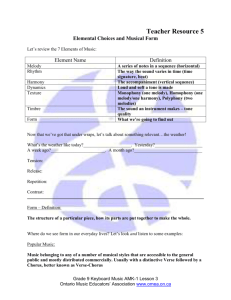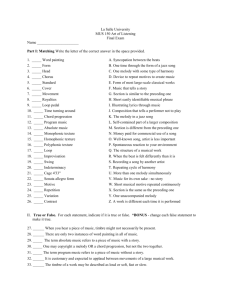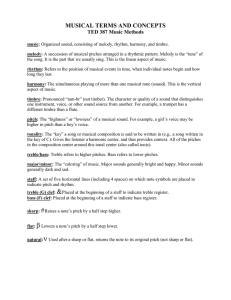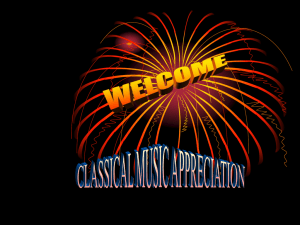The Elements of Music
advertisement
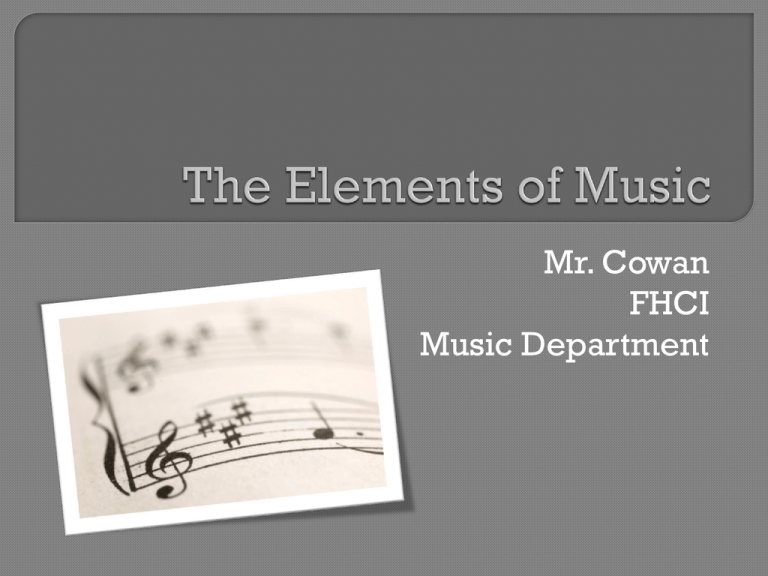
Mr. Cowan FHCI Music Department There are seven primary elements. All music contains all of them to a certain degree. When discussing these musical elements, it is difficult, if not impossible, to talk about one element without referring to another. For example, pitch cannot be separated from time, because pitch happens in time! You can’t have a melody without some type of rhythm. To put it another way, music is irreducible beyond these elements. By that I mean, you cannot remove one of the above elements and still have music. Even music made up of all unpitched percussion instruments has pitch, it’s just not easily perceivable. We separate music into these elements for the sake of teaching and discussion. But in actual music, all of the elements function together as one. The duration of all of the sounds and silences in music. Rhythm changes constantly over the steady and unchanging beat. The steady beat provides the foundation over which rhythm is organized. The combinations of long and short, even and uneven sounds that convey a sense of movement. The movement of sound through time. We shape time today musically by dividing it into measurable units. Meter: none, 2/4, 3/4 , 4/4, 6/8, etc. (repeating patterns forming a pulse group) The beat, a regularly recurring pulse, is the most basic unit of musical time. How fast the beat moves is called the tempo. (slow, moderate, fast) Rhythm is the element of musical time that brings the music to life. Drums….1) slow 2) moderate 3) fast Movement in music with a feeling of regularity & differentiation Pulse: regular (ticking clock) vs. irregular (hail on your roof) irregular can become regular if repeated Example #1) Buena Vista Social Club: Example #2) Bob Marley: Example 3: Tool "Schism" is renowned for its use of uncommon time signatures and the frequency of its meter changes. In one analysis of the song, the song alters meter 47 times.[4] The song begins with two bars of 5/4, followed by one bar of 4/4, followed by bars of alternating 5/8 and 7/8, until the first interlude, which consists of alternating bars of 6/8 and 7/8. The following verse exhibits a similar pattern to the first, alternating bars of 5/8 and 7/8. The next section is bars of 6/4 followed by one bar of 11/8. This takes the song back into alternating 5/8 and 7/8. Another 6/8 and 7/8 section follows, and after this the song goes into repeating 7/8 bars. The middle section is subsequently introduced, consisting of three bars of 6/8, one bar of 3/8, and one bar of 3/4 repeating several times. At one point it interrupts with two bars of 6/8 followed by a bar of 4/8, twice. A bar of 5/8 is played before the meter switches back to 6/8 for two bars and 2/4 for one bar. This repeats, setting up another section: two bars of 9/8 followed by a bar of 10/8, that pattern again, and then a single bar of 9/8 followed by alternating bars of 6/8 and 7/8. The outro has alternating bars of 5/8 and 7/8, ending with alternating 6/8, 2/8 that one could interpret as pulsing with a 4/4 feel. The band has referred to the time signature as 6.5/8.[5] Although many composers would use 13/16 instead, 6.5/8 is still a valid fractional time signature. Melody, to many music lovers, is the most important part of music. It’s common to refer to a melody that is easy to remember and easy to sing as a tune. One pitch followed by another, or a succession of pitches in time the horizontal dimension of musical space. 1) a “tune” which can be whistled or hummed 2) Generally, what we remember in a piece of music 3) 2 fundamental qualities: Pitch and Duration 4) Refers to a series of individual notes 5) Horizontal Concept 2) Pitch is the element of music that allows us to hear sounds as either high or low Any time objects vibrate at a consistent rate, we perceive pitch. Strings are the easiest way to “see” what we’re hearing. Pluck the string of a guitar and you see it vibrating consistently. That consistent vibration creates the pitch that you hear. The faster the string vibrates, the higher the pitch sounds. 3) Motif: a brief musical idea that is repeated and developed throughout a piece • Main ingredient to a piece of music Metaphorically then, we say that pitch is the vertical dimension of musical space. And because music happens in time, it seems logical to say that musical time is the horizontal dimension of musical space. Pitch and time, then, give us two dimensions of musical space: Harmony Some music lovers are attracted most by harmony. Most of us, I think, would agree that the best music has both memorable melodies and harmonies. For now though, when we talk about harmony, we are referring to: • 1) two or more pitches happening at the same time • 2) the vertical dimension of musical space. • 3) The combination of simultaneously produced musical notes to produce chords and chord progressions with a pleasing effect The sounding of notes together Vertical concept Visual Representation: Example #1: Piano...C,E,G individually = melody Piano....C,E,G Leads together = harmony us into intervals, chords, etc. Any and all types of music From pop music, to rock, to barbershop 1) Fleet Foxes: Sun Giant 2) The Beach Boys: Good Vibrations 3) The Beatles: The organization of the piece – the shape & order in which a piece of music is composed. Examples include: theme & variations, rondo, blues form, verse/chorus, bridge, introduction, length of phrases etc. The design of music, incorporating repetition, contrast, unity, and variety. The organization of music, its shape or structure. Typical Pop Music Form: Introduction Verse #1 Chorus #1 Verse #2 Chorus #2 Bridge Chorus #3 Outro I – V1 – C1 – V2 – C2 – B – C3 - O The quality of a musical note or sound which distinguishes different types of sound production or musical instruments Also known as “tone colour” Acoustic vs. Amplified Smooth vs. Rough Crisp/Sharp vs. Soft/Muddy Lastly, timbre is important in performance. Part of learning to create quality sounds on your instrument involves learning how to produce good tone quality, or good timbre. Bright, Dark, Brassy, Warm, Raspy, Smooth etc. Musical texture ranges from very simple to rather complex. It is the relationship of “melodic” and “harmonic” elements which can interweave like threads in a cloth If the texture is too simple for too long of a period of time, we, as listeners, tend to get bored. If it is too complicated (too many events happening at once), the music gets confusing, and we stop listening. Monophonic: is a single melody with nothing else going on around it: no accompaniment, no harmony, just the melody. Polyphonic: Literally means “many voices” Two or more simultaneous sounding melodies (round: row row row your boat) Homophonic: A melody with a harmonic accompaniment (guitar and vocals) In music, we define dynamics as the relative loudness or softness of volume throughout a piece of music Relative is an important word here. Musical dynamics cannot be designated in decibels or any other scientific measurement of volume or intensity “loud” (or the Italian term, forte) means something different depending on the context. p – piano – soft pp – pianissimo – very soft f – forte – strong (loud) ff – fortissimo – very strong (very loud) m – mezzo – means medium or moderately and can be added to either a “p” or a “f” crescendo – gradually increase volume decrescendo – gradually decrease volume





